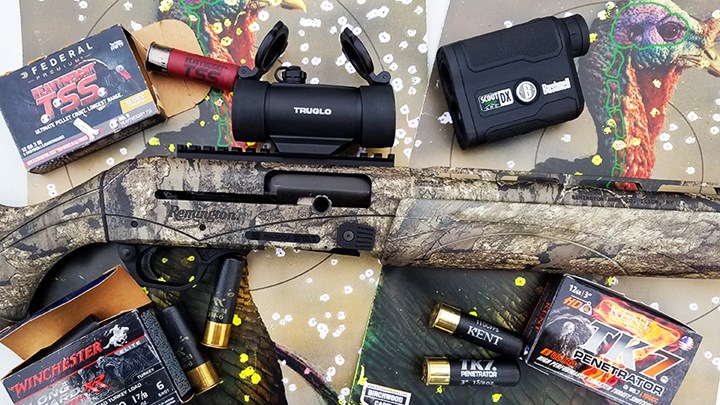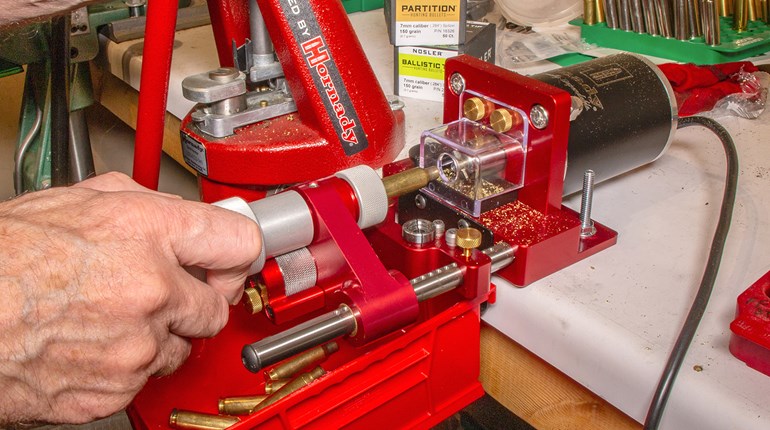
Whether your shotgun is for shooting clay games, hunting or even home defense, it's important to make sure that the choke and shells you've chosen for it are working the way you want them to. The process of doing that is called "patterning" or "testing shotgun patterns," and it's relatively simple to do (although some of the steps are a little different depending on what type of shotgun you have). All you'll need is your shotgun, your ammunition, a few pieces of paper at least 4 feet wide and a sturdy frame large enough to hold them. Here's what to do:
1. Check, then double-check, that your shotgun is unloaded, then thoroughly clean the bore of your shotgun using a suitable solvent and brush.
2. Carefully inspect the bore of your shotgun, making certain there are no obstructions or damage, and any choke tubes in use are securely seated.
3. Select an appropriate, factory-loaded shotshell that you'll use for your intended purpose.
4. Mount a sheet of pattern paper at least 4 feet wide upright on a sturdy wooden frame. Draw an aiming point in the center (a 4-6-inch diameter solid black circle works well).
5. For a skeet gun or a .410-bore, measure back 25 yards from your target. For all other guns, measure back 40 yards. Place a ground marker on that spot for reference, so you can fire from exactly the same place each time.
6. Fire one shot on each sheet of pattern paper, remove it, then replace it with a fresh sheet. We recommend numbering each sheet and noting the barrel (if you're using an over/under or side-by-side) and the load.
7. Determine the number of shots you need to fire for each barrel/choke/load combination using the following criteria:
- To determine choke pattern performance with 95 percent statistical certainty, fire and evaluate five shells. This is suitable for hunting and casual target shooting purposes.
- To determine choke pattern performance to a statistically more rigorous 98-percent certainty, fire and evaluate 10 shells. For engineering and research work, 20.
8. Lay each perforated pattern sheet in turn on a white or transparent flat surface, then scribe a 30-inch-diameter circle on each sheet in the location that includes the greatest number of the holes your pellets left. Mark the center of the circle (ignoring the aiming point you drew on there earlier). Scribe a 20-inch-diameter concentric circle within your 30-inch circle, then draw a vertical line and a horizontal line through the center of the two circles. You have now divided the pattern into eight parts.
9. Count the number of pellet hits in each segment. Add the number of hits in both the 20-inch and the 30-inch circles. Repeat for each pattern sheet.
10. Add the total number of all hits within the 30-inch circles, and divide by the number of pattern sheets. This will give you the average number of pellet hits inside the circle.
11. Determine the pellet count for each round by checking the manufacturer's specs for that particular ammunition.
12. You're now in a position to analyze choke performance from your shotgun. Most shooters seek to determine only three factors in choke performance:
- The overall percentage of pellet hits in the 30-inch circle. This number is determined by dividing the average number of pellet hits in the 30-inch circle (step 10) by how many pellets should be in each round.
- The evenness of pellet distribution in the 30-inch circle. Most shooters judge this by visually reviewing hit distribution on the pattern sheets.
- The pattern's center of impact in relation to the point of aim. In other words, does your gun pattern dead-on, high, low, left or right? Most shooters determine this by noting the position of the center of the circles in relation to the aim point they drew on.
13. Now you're ready to evaluate the results you found in step 12.
- Your percentage of pellet hits (from 12a above), aka expected choke performance in a 30-inch circle at 40 Yards is as follows:
- Cylinder: 40 percent
- Improved Cylinder: 50 percent
- Modified: 60 percent
- Improved Modified: 65 percent
- Full: 70 percent
- Extra Full: 80 percent
- Hit distribution in the pattern (from 12b above):
- Central thickening: Compare total hits in the 20-inch circle versus the 30-inch circle
- Hits in quadrants: Compare the total hits in quadrants
- Hits in segments: Compare hits in the 1/8 segments
- Pattern center point of impact:
- Field Guns: most field guns are stocked and sighted to place the pattern center slightly high at 40 yards.
- upland bird: 2-4 inches high at 40 yards
- migratory waterfowl like ducks: 4-6 inches high at 40 yards
- small game: dead-on to 2 inches high at 25 yards
- Target Guns:
- skeet: dead-on to 2 inches high at 25 yards
- trap: 6-8 inches high at 40 yards
- sporting clays: 2-4 inches high at 40 yards
- Field Guns: most field guns are stocked and sighted to place the pattern center slightly high at 40 yards.






































